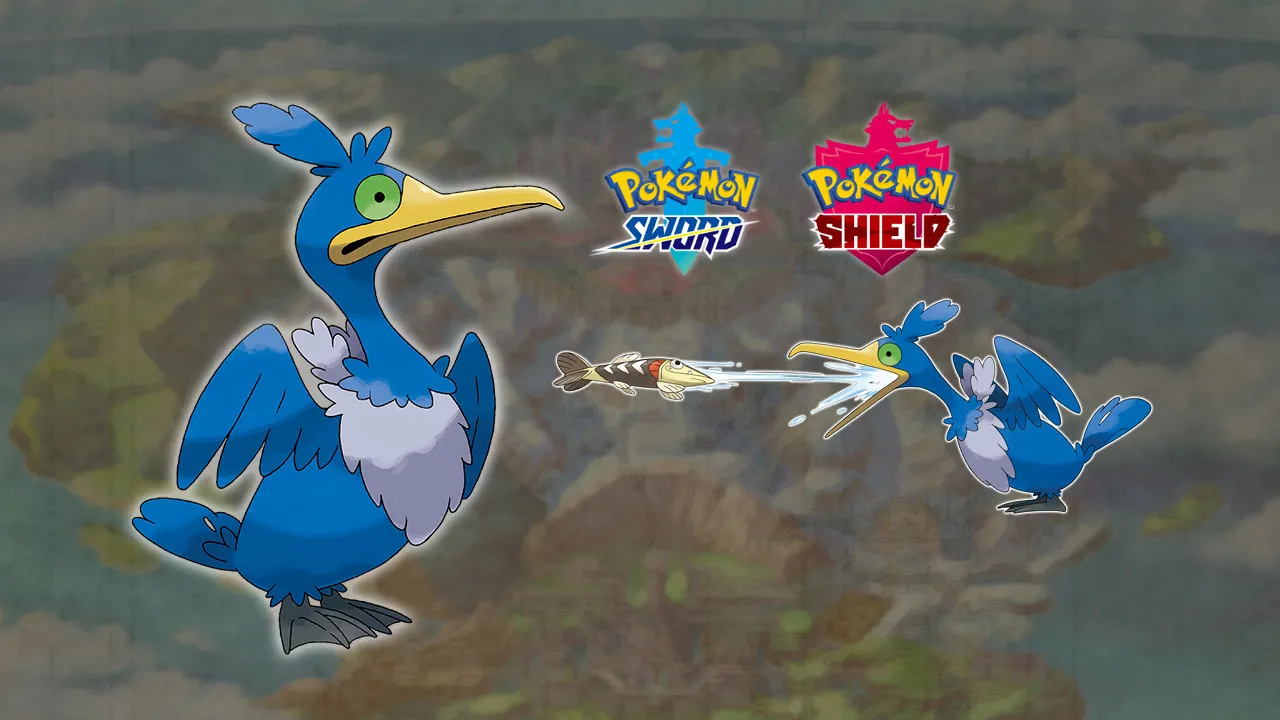Step into the enchanting world of Pokémon as we embark on a journey to uncover the mysteries behind one of its most fascinating creatures: Cramorant! With its distinctive appearance and intriguing behaviours, Cramorant has captured the hearts and imaginations of trainers worldwide. Join us as we delve into the depths to discover where these magnificent birds dwell, what they devour with gusto, how they propagate their species, and ultimately, why they hold such significance in the Pokémon realm. Get ready for an adventure like no other as we unveil the captivating world of Cramorant! Soar with us through this comprehensive guide that will leave you spellbound by these extraordinary avian marvels. Let’s dive right in!
What are cramorants?
Cramorants are magnificent avian creatures that belong to the Pokémon universe. Their unique appearance and captivating behaviours have become a favourite among trainers and enthusiasts alike. These water-type Pokémon resemble large seabirds with striking blue feathers and a distinctive hooked beak.
Known for their exceptional diving abilities, Cramorants can plunge into the depths of bodies of water in search of prey. They possess extraordinary agility and speed underwater, making them formidable hunters. Their long necks allow them to reach deep into the water to catch fish or other aquatic creatures.
One fascinating aspect of Cramorant’s physiology is its expandable throat pouch. This specialized feature enables it to swallow its prey whole while hunting underwater. Upon surfacing, however, this pouch tends to fill up with air rather comically, resembling a balloon ready to burst!
Despite their somewhat clumsy appearance on land due to their webbed feet designed for swimming, Cramorants are graceful flyers once airborne. They soar effortlessly through the sky using their powerful wingspans.
In battles against opponents, Cramorants demonstrate remarkable resilience and adaptability. Their ability, Gulp Missile, allows them to retaliate by spitting out whatever they’ve swallowed if attacked while holding something in their mouths – an unexpected defensive move that often catches adversaries off guard.
So there you have it – an introduction to the marvellous world of cramorants! From their distinctive physical features and incredible diving skills to their quirky behaviour both above and below the surface, these avian wonders continue to captivate trainers worldwide with every encounter. Stay tuned as we delve deeper into other intriguing aspects of cramorant life!
Where do cramorants live?
Where do cramorants live? These fascinating creatures can be found in various parts of the world, including coastal regions and inland bodies of water. Cramorants are highly adaptable birds that have managed to thrive in diverse habitats.
In coastal areas, you may come across cramorants perched on rocky cliffs or jutting out from piers and jetties. They are often seen near estuaries, where they can feast on an abundance of fish and other aquatic creatures.
These birds also make their homes around lakes, rivers, and wetlands. They are skilled divers and swimmers who feel right at home in freshwater environments. You might spot them gracefully gliding across the water’s surface before swiftly diving to catch their prey.
Cramorants have even been known to venture inland occasionally. In some places, they have adapted to urban environments and can be seen nesting on buildings or bridges close to water sources.
No matter where they reside, cramorants bring a unique charm with their distinctive appearance and behaviour. So keep your eyes peeled when exploring coastlines or visiting bodies of water – you never know when one of these remarkable birds will appear!
What does a cramorant eat?
Cramorants are fascinating creatures with equally fascinating eating habits. These aquatic birds have an insatiable appetite for fish and will go to great lengths to catch their prey. Using their sharp beaks and agile bodies, cramorants dive into the water for small fish.
Once underwater, they swim swiftly and skillfully, using their wings as paddles to propel themselves forward. With their excellent eyesight, they can easily spot even the tiniest fish swimming below the surface. When they locate their target, cramorants open their long bills wide and swiftly snatch up the unsuspecting fish.
But here’s where things get interesting – after catching a meal, cramorants have a peculiar habit of swallowing it whole! Yes, you read that right. These remarkable birds gulp down fish much more significant than what seems physically possible for them to eat.
However, these daring divers sometimes bite off more than they can chew (literally). Cramorants occasionally overestimate the size of their quarry and end up with a mouthful that is too large to swallow comfortably. In such cases, you might witness an amusing sight – a cramorant frantically shaking its head or trying various acrobatic maneuvers to maneuver the oversized meal into its throat!
Cramorants are highly efficient hunters who feed themselves on speed and precision. Their diet primarily consists of smaller species like minnows or herring, but depending on availability, some may also include crustaceans or amphibians in their menu.
So next time you come across these remarkable birds during your nature walks by rivers or lakeshores, remember: beneath those sleek feathers lies an impressive hunter capable of capturing meals many times its size!
How do cramorants breed?
Breeding is a crucial part of any species’ life cycle, and cramorants are no exception. These fascinating creatures have their unique ways of reproducing.
Cramorants typically form breeding colonies, gathering in large groups to find mates and raise their young. These colonies can be found in various coastal areas around the world.
During the breeding season, male cramorants engage in elaborate courtship displays to attract females. They may perform intricate dances or show off their colourful plumage to catch the attention of potential partners.
Once a pair has formed, they construct nests using sticks, vegetation, and other materials. The nests are often built on cliffs or trees near bodies of water for easy access to food.
Female cramorants lay two to four eggs at a time. Both parents take turns incubating the eggs and keeping them warm until they hatch. This shared responsibility ensures that both parents are actively involved in raising their offspring.
After hatching, the chicks rely on their parents for food and protection. The adults regurgitate partially digested fish into the mouths of their hungry youngsters—a sight that might seem unusual but is essential for their survival.
As the chicks grow older and gain strength, they begin venturing out from the nest to explore their surroundings and learn how to hunt for themselves. Eventually, they will leave the colony to start their own families when they reach reproductive maturity.
The breeding process of cramorants is intriguing and vital for maintaining healthy populations of these remarkable birds in our ecosystems.
What is the significance of the cramorant?
Cramorants, with their unique characteristics and behaviours, hold a significant place in the fascinating world of avian species. These remarkable birds have captured the attention of bird enthusiasts and researchers alike for many reasons.
One significant aspect of cramorants is their role as indicators of ecosystem health. As diving waterbirds, they rely on healthy aquatic habitats to thrive. By studying cramorant populations and monitoring their behavior, scientists can gain valuable insights into the overall well-being of water ecosystems.
Another noteworthy significance lies in cramorants’ feeding habits. They are voracious predators that consume various fish, allowing them to control specific fish populations naturally. This ecological balance helps maintain biodiversity within ecosystems.
Cramorants also play an essential role in nutrient cycling. When they eat fish, they excrete waste rich in nitrogen and phosphorus onto land or back into water bodies where they forage. This natural fertilization contributes to the growth and productivity of plants surrounding these areas.
Furthermore, these charismatic birds possess cultural significance in different regions worldwide. In some societies, cramorants feature prominently in folklore and mythology or are revered as symbols representing traits such as resilience or adaptability.
Understanding the significance of cramorants goes beyond a mere appreciation for their beauty; it involves recognizing their contribution to ecological balance and cultural heritage while shedding light on crucial environmental conservation efforts worldwide.
Conclusion
In this comprehensive guide, we have delved into the fascinating world of Cramorant. These unique water birds are known for their distinctive appearance and exciting behaviours. From their diverse habitats to their varied diet, Cramorants truly captivate the imagination.
Cramorants can be found in various regions worldwide, including Europe, Asia, and North America. They make their homes near bodies of water such as lakes, rivers, and coastal areas. With their exceptional diving abilities, they can explore underwater environments for food.
Speaking of food, Cramorants have quite an appetite! Their diet mainly includes fish and other aquatic creatures like eels and crustaceans. With a swift plunge into the water, these birds can catch prey with remarkable precision.
Breeding is another intriguing aspect of Cramorant life. They typically form large colonies during breeding season and engage in elaborate courtship displays to attract mates. The females lay eggs in nests built on elevated platforms or structures near the water’s edge.
The significance of Cramorants goes beyond just being visually captivating creatures. As top predators in aquatic ecosystems, they are essential in maintaining balance within these fragile environments.
So next time you spot a graceful bird perched by a body of water or witness its impressive diving skills as it disappears beneath the surface – remember that you’re observing one of nature’s most remarkable creations: the magnificent Cramorant!
Now that you’ve gained insights into their habitat preferences, feeding habits, breeding behaviour and ecological importance – take a moment to appreciate these incredible avian wonders whenever you encounter them!
Explore more about cramorants with our comprehensive guide today!





